Growing the Family: The New ATI FireGL V Series
ATI introduces six new PCI Express boards, including the first 1GB workstation graphics accelerator.
December 4, 2001
By David Cohn
Less than two years after it began shipping its first PCI Express-based graphics accelerators, ATI is back with a whole new family of FireGL 3D boards. These second-generation boards all offer new graphics processing units and more memory. In addition, features that were previously found on higher-level boards have migrated down toward the less-expensive end of the product lineup.
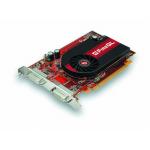 |
| Photo by David Cohn. |
› › The ATI FireGL V3300.
ATI has also updated its underlying video technology, which it has now branded as Avivo. The new Avivo technology includes true 64-bit per pixel floating-point High Dynamic Range (HDR) rendering support capable of more than one trillion colors. This results in a finer level of detail throughout the visible spectrum. In addition, high-end displays supporting 16-bit per RGB color component can be fully utilized by the new boards.
The Second Generation
Its first generation of PCI Express graphics accelerators included five members spanning a range from entry-level to the high-end. This year’s family consists of a total of six new boards that bridge the spectrum from budget entry-level 3D graphics to the ultra high-end, once the domain of the now defunct 3D Labs.
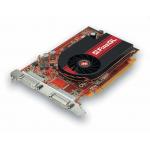 |
| Photo by David Cohn. |
‹ ‹ The FireGL V3400 PCI Express graphics card from ATI Technologies.
At the entry level, the new FireGL V3300 ($249 MSRP/$199 average street price) provides 128MB of DDR2 memory using a 64-bit memory controller interface and a GPU (graphics processor unit) with two parallel geometry engines and four pixel-shader processors. Unlike last year’s entry-level boards that offered only one DVI connector and one analog VGA connector, ATI now includes two DVI-I connectors even on this entry-level board. The GPU’s 6.4GB/second bandwidth delivers 300 million vertices per second and 2.4 billion pixel operations per second. The V3300 is one of the two new ATI boards covered here that we did not test (the other being the V7300).
The FireGL V3400 ($399 MSRP/$279 street) represents a small step up from the base-level board, and also represents a substantial jump in performance. It too comes with 128MB of memory, but here it is GDDR3 graphics memory with a 256-bit ring bus memory controller and a GPU with five parallel geometry engines and 12 pixel-shader processors, which combine to deliver 16GB/second bandwidth. This yields 625 million vertices per second and 6 billion pixel operations per second. In addition, one of the board’s two DVI-I connectors supports dual link, enabling this entry-level board to drive one of the increasingly popular ultra-high-resolution displays such as the 30-inch Apple Cinema Display, which has a resolution of 2560 x 1600. The dual-link output is actually capable of resolutions up to 3840 x 2400. The FireGL V3400 also includes high-definition component video output.
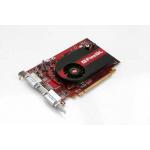 |
| Photo by David Cohn. |
› › The new mid-range ATI FireGL V5200.
For the mid-range, ATI introduced the new FireGL V5200 ($699 MSRP/$560 street). This board doubles the amount of GDDR3 memory to 256MB, while retaining a similar memory controller and GPU. But the extra memory helps increase the memory bandwidth to 22.4GB/second and boosts performance to 750 million vertices and 7.2 billion pixel operations per second. The V5200 also includes dual-link support on both of its DVI-I ports.
The FireGL V7200 ($1,099 MSRP/$890 street) is ATI’s new high-end graphics accelerator, but the high-end is no longer the end of ATI’s spectrum. This board comes with 256MB of GDDR3 graphics memory, but uses a 512-bit ring bus memory controller, yielding a memory bandwidth of 41.6GB/second. In addition, the GPU in the V7200 has eight parallel geometry engines and 16 pixel-shader processors. Together, this boosts the board’s performance to 1.2 billion vertices and 9.6 billion pixel operations per second. In addition to its two dual-link DVI-I connectors, the board also supports stereoscopic 3D output. The V7200’s power comes at the expense of higher power consumption, requiring the use of an auxiliary connection to the system power supply. The V7200 also sports a large cooling fan that protrudes more than an inch from the board, rendering the adjacent expansion slot unavailable.
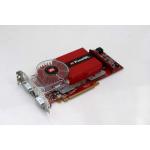 |
| Photo by David Cohn. |
‹ ‹ The high-end ATI FireGL V7200.
With the introduction of the FireGL V7300 ($1,599 MSRP/$1,250 street), ATI ventures for the first time into the realm of ultra-high-end graphics. The board comes with 512MB of GDDR3 graphics memory supported by a 512-bit ring bus memory controller. Like the V7200, the GPU in the V7300 has eight parallel geometry engines and 16 pixel-shader processors. It delivers virtually the same number of vertices and pixel operations per second. But the extra memory does enable the V7300 to handle much larger datasets.
Rather than send DE a V7300, ATI elected instead to provide its other new ultra-high-end graphics accelerator, the FireGL V7350 ($1,999 MSRP/$1,599 street), a card with the distinction of being the industry’s first 1GB workstation graphics accelerator.
 |
| Photo by David Cohn. |
› › The new ultra-high-end ATI FireGL V7300 comes with 512MB of graphics memory.
Other than the amount of onboard GDDR3 memory, the V7300 and V7350 are quite similar. Both use a 512-bit bus ring memory controller delivering the same 41.6GB/second memory bandwidth. The board provides two dual-link DVI-I connectors, a stereo 3D connector, and high-definition video output. And the V7350 GPU has the same number of processors and delivers the same 1.2 billion vertices and 9.6 billion pixel operations per second. Like the V7200, both the V7300 and V7350 require extra power and protrude into the adjacent expansion slot. ATI will also offer an optional Genlock/Framelock daughter card for these boards in the second half of the year.
Benchmarking the Boards
HP has been gracious enough to loan DE the xw4200 workstation we’ve used as the test platform for past graphics board reviews, so that all PCI Express-based boards can be tested in the same computer. The xw4200—the same system we reviewed in the August 2004 issue of Desktop Engineering—is equipped with a 3.4GHz single-core CPU, 2GB of DDR2 memory, and a pair of SATA drives configured in a Raid 0 array.
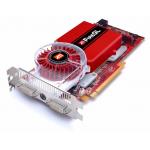 |
| Photo by David Cohn. |
‹ ‹ The new ultra-high-end FireGL V7350, the industry’s first 1GB workstation graphics accelerator. Like the V7200 and V7300, the large fan protrudes into the adjacent slot.
To judge performance, we ran version 8.1 of the SPECviewperf benchmark (spec.org). For comparison purposes, we also re-tested last year’s boards using this newer benchmark, and we’ve included those results as well. (Click here to download an Excel file of the benchmarks results.)
All of the new ATI boards clearly outperformed the first-generation ATI boards in each product range—entry-level, mid-range, and high-end. And the V7350, V7300, and V7200 even outperformed the 3DLabs Wildcat Realizm 800—the former ultra-high-end champ—on three of the eight SPEC viewperf tests.
All of the new ATI FireGL boards are fully certified with most CAD and DCC (digital content creation) applications. All of the boards in the ATI FireGL line use the same unified video driver, including the earlier boards. Drivers are available for Windows XP, Windows XP64, and Windows 2000 as well as Linux 32 and Linux 64. And all six boards are Windows Vista ready. The new boards also include ATI’s Avivo technology and support OpenGL 2.0 and Microsoft DirectX 9.0. ATI backs the boards with a three-year warranty and toll-free phone and e-mail technical support.
ATI continues to sell and support last year’s FireGL PCI Express boards as well as its two FireGL AGP boards. But with significantly improved performance, the more robust Avivo technology, and better value by virtue of price/performance improvements and enhanced features in its lower-cost boards, this year’s boards will quickly eclipse the others. There’s no question that CAD users now have even more choices than ever before.
David Cohn is a computer consultant and technical writer based in Bellingham, WA. He’s a Contributing Editor to Desktop Engineering, the Editor-in-Chief of Engineering Automation Report and CADCAMNet published by Cyon Research, and the author of more than a dozen books. You can contact David through his website or click here to send him an e-mail about this article.
ATI FireGL V Series
ATI Technologies Inc.
Markham, Ontario
Requirements
PCI Express-based workstation with available x16 lane graphics slot; Linux, Microsoft Windows 2000, Windows XP, Windows XP 64-bit Edition; 512MB of system memory; 350 watt power supply (450 watt and auxiliary power connector required for V7200, V7300, and V7350)
Pricing
ATI FireGL V3300
$249 (suggested retail), $199 (average street)
ATI FireGL V3400
$399 (suggested retail), $279 (average street)
ATI FireGL V5200
$699 (suggested retail), $560 (average street)
ATI FireGL V7200
$1,099 (suggested retail), $890 (average street)
ATI FireGL V7300
$1,599 (suggested retail), $1,250 (average street)
ATI FireGL V7350
$1,999 (suggested retail), $1,599 (average street)
Subscribe to our FREE magazine, FREE email newsletters or both!
About the Author
David Cohn is a consultant and technical writer based in Bellingham, WA, and has been benchmarking PCs since 1984. He is a Contributing Editor to Digital Engineering, the former senior content manager at 4D Technologies, and the author of more than a dozen books. Email at [email protected] or visit his website at www.dscohn.com.
Follow DE





